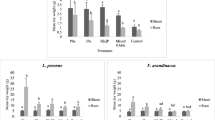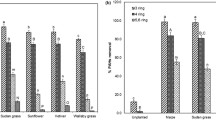Abstract
Purpose
Phytoremediation has been recognized as a promising technology for the remediation of polycyclic aromatic hydrocarbon (PAH)-contaminated soils. However, little is known about how plant species and cropping patterns affect the process of phytoremediation removing PAHs. Therefore, the aim of this study was to investigate further the effects of monocultures or mixed cultures of different plant species on PAH phytoremediation.
Materials and methods
Soils were sampled from a coke plant in Beijing, and ryegrass, white clover, and celery were selected as the model plants. Pot experiment was conducted in a greenhouse using these plants as mono-, two-, and three-species mixed cultures for 75 days. At the end of the experiment, the soil and plant samples were collected for PAH analysis. Moreover, the lipid content and fresh biomass of plants were also determined.
Results and discussion
The average remaining percentage of PAHs in mixtures (48%) was significantly lower than those in monocultures (55%) and nonplanted soils (70%). In all treatments, plant-promoted biodegradation accounted for almost 99% plant-enhanced PAH losses, but plant uptake only contributed less than 2%. Between individual PAHs, 2–4-ring PAHs were generally more affected by plant uptake, especially for celery and mixed cultures, while 3–6-ring PAHs were impacted the most by biodegradation which was most enhanced in the presence of multispecies mixtures.
Conclusions
Our results suggest that certain multispecies mixtures facilitate the phytoremediation of PAH-contaminated soils over monocultures. Moreover, plant-promoted biodegradation was the major pathway for PAH phytoremediation, whereas plant uptake was the minor one. Both of these pathways were dependent on plant species, cropping pattern, and PAH size.

Similar content being viewed by others
References
Abhilash PC, Jamil S, Singh N (2009) Transgenic plants for enhanced biodegradation and phytoremediation of organic xenobiotics. Biotechnol Adv 27:474–488
AOAC (2000) Official Methods of Analysis of AOAC International, 17th edn. Association of Official Analytical Chemists, Gaithersburg
Cébron A, Beguiristain T, Faure P, Norini MP, Masfaraud JF, Leyval C (2009) Influence of vegetation on the in situ bacterial community and polycyclic aromatic hydrocarbon (PAH) degraders in aged PAH-contaminated or thermal-desorption-treated soil. Appl Environ Microbiol 75:6322–6330
Cheema SA, Khan MI, Shen CF, Tang XJ, Farooq M, Chen L, Zhang CK, Chen YX (2010) Degradation of phenanthrene and pyrene in spiked soils by single and combined plants cultivation. J Hazard Mater 177:384–389
Chen Y, Banks MK, Schwab AP (2003) Pyrene degradation in the rhizosphere of tall fescue (Festuca arundinacea) and switchgrass (Panicum virgatum L.). Environ Sci Technol 37:5778–5782
Chiou CT, Sheng GY, Manes M (2001) A partition-limited model for the plant uptake of organic contaminants from soil and water. Environ Sci Technol 35:1437–1444
Cooper KM, Lösel DM (1978) Lipid physiology of vesicular-arbuscular mycorrhiza. 1. Composition of lipids in roots of onion, clover and ryegrass infected with Glomus mosseae. New Phytol 80:143–151
Fan SX, Li PJ, Gong ZQ, Ren WX, Na H (2008) Promotion of pyrene degradation in rhizosphere of alfalfa (Medicago sativa L.). Chemosphere 71:1593–1598
Gao YZ, Zhu LZ (2004) Plant uptake, accumulation and translocation of phenanthrene and pyrene in soils. Chemosphere 55:1169–1178
Gerhardt KE, Huang XD, Glick BR, Greenberg BM (2009) Phytoremediation and rhizoremediation of organic soil contaminants: potential and challenges. Plant Sci 176:20–30
Harvey PJ, Campanella BF, Castro PML, Harms H, Lichtfouse E, Schaffner AR, Smrcek S, Werck-Reichhart D (2002) Phytoremediation of polyaromatic hydrocarbons, anilines, and phenols. Environ Sci Pollut Res 9:29–47
Huang XD, El-Alawi Y, Penrose DM, Glick BR, Greenberg BM (2004) A multiprocess phytoremediation system for removal of polycyclic aromatic hydrocarbons from contaminated soils. Environ Pollut 130:465–476
Huesemann MH, Hausmann TS, Fortman TJ, Thom RM, Cullinan V (2009) In situ phytoremediation of PAH- and PCB-contaminated marine sediments with eelgrass (Zostera marina). Ecol Eng 35:1395–1404
Joner EJ, Leyval C (2003) Rhizosphere gradients of polycyclic aromatic hydrocarbon (PAH) dissipation in two industrial soils and the impact of arbuscular mycorrhiza. Environ Sci Technol 37:2371–2375
Khan S, Aijun L, Zhang SZ, Hu QH, Zhu YG (2008) Accumulation of polycyclic aromatic hydrocarbons and heavy metals in lettuce grown in the soils contaminated with long-term wastewater irrigation. J Hazard Mater 152:506–515
Lee SH, Lee WS, Lee CH, Kim JG (2008) Degradation of phenanthrene and pyrene in rhizosphere of grasses and legumes. J Hazard Mater 153:892–898
Lu RK (1999) Analytical Methods for Soils and Agricultural Chemistry. Agricultural Science and Technology Press, Beijing
Maila MP, Randima P, Cloete TE (2005) Multispecies and monoculture rhizoremediation of polycyclic aromatic hydrocarbons (PAHs) from the soil. Int J Phytoremediat 7:87–98
Maliszewka-Kordybach B (1996) Polycyclic aromatic hydrocarbons in agricultural soils in Poland: preliminary proposals for criteria to evaluate the level of soil contamination. Appl Geochem 11:121–127
Mueller KE, Shann JR (2006) PAH dissipation in spiked soil: Impacts of bioavailability, microbial activity, and trees. Chemosphere 64:1006–1014
Olson PE, Castro A, Joern M, DuTeau NM, Pilon-Smits EAH, Reardon KF (2007) Comparison of plant families in a greenhouse phytoremediation study on an aged polycyclic aromatic hydrocarbon-contaminated soil. J Environ Qual 36:1461–1469
Olson PE, Castro A, Joern M, DuTeau NM, Pilon-Smits E, Reardon KF (2008) Effects of agronomic practices on phytoremediation of an aged PAH-contaminated soil. J Environ Qual 37:1439–1446
Phillips LA, Greer CW, Farrell RE, Germida JJ (2009) Field-scale assessment of weathered hydrocarbon degradation by mixed and single plant treatments. Appl Soil Ecol 42:9–17
Rezek J, Wiesche CID, Mackova M, Zadrazil F, Macek T (2008) The effect of ryegrass (Lolium perenne) on decrease of PAH content in long term contaminated soil. Chemosphere 70:1603–1608
Vervaeke P, Tack FMG, Navez F, Martin J, Verloo MG, Lust N (2006) Fate of heavy metals during fixed bed downdraft gasification of willow wood harvested from contaminated sites. Biomass Bioenergy 30:58–65
Wei SQ, Pan SW (2010) Phytoremediation for soils contaminated by phenanthrene and pyrene with multiple plant species. J Soils Sediments 10:886–894
Wenzel WW (2009) Rhizosphere processes and management in plant-assisted bioremediation (phytoremediation) of soils. Plant Soil 321:385–408
Xu SS, Liu WX, Tao S (2006a) Emission of polycyclic aromatic hydrocarbons in China. Environ Sci Technol 40:702–708
Xu SY, Chen YX, Wu WX, Wang KX, Lin Q, Liang XQ (2006b) Enhanced dissipation of phenanthrene and pyrene in spiked soils by combined plants cultivation. Sci Total Environ 363:206–215
Xu SY, Chen YX, Lin KF, Chen XC, Lin Q, Li F, Wang ZW (2009) Removal of pyrene from contaminated soils by white clover. Pedosphere 19:265–272
Yi H, Crowley DE (2007) Biostimulation of PAH degradation with plants containing high concentrations of linoleic acid. Environ Sci Technol 41:4382–4388
Zhang JY, Zhao W, Pan J, Qiu LM, Zhu YM (2005) Tissue-dependent distribution and accumulation of chlorobenzenes by vegetables in urban area. Environ Int 31:855–860
Acknowledgments
This work was supported by the Ministry of Science and Technology, China (2007CB407304) and the National Natural Science Foundation of China (20807053).
Author information
Authors and Affiliations
Corresponding author
Additional information
Responsible editor: Peter Schröder
Electronic supplementary materials
Below is the link to the electronic supplementary material.
ESM 1
(DOC 1,315 kb)
Rights and permissions
About this article
Cite this article
Meng, L., Qiao, M. & Arp, H.P.H. Phytoremediation efficiency of a PAH-contaminated industrial soil using ryegrass, white clover, and celery as mono- and mixed cultures. J Soils Sediments 11, 482–490 (2011). https://doi.org/10.1007/s11368-010-0319-y
Received:
Accepted:
Published:
Issue Date:
DOI: https://doi.org/10.1007/s11368-010-0319-y




